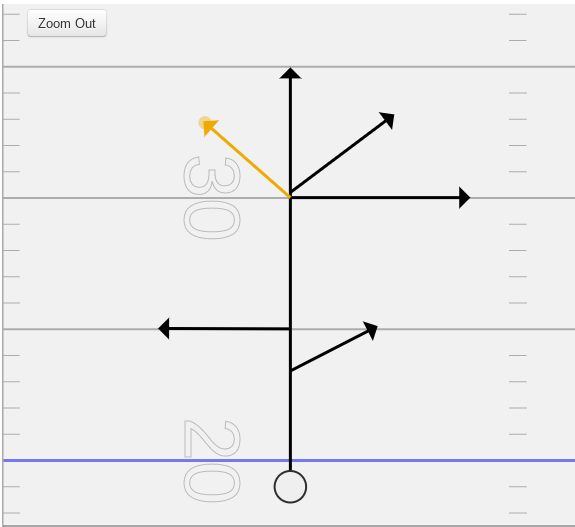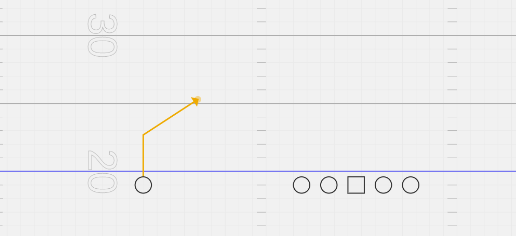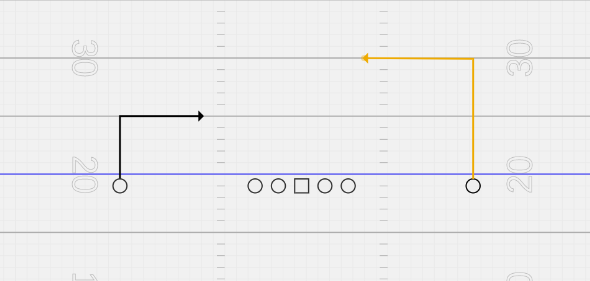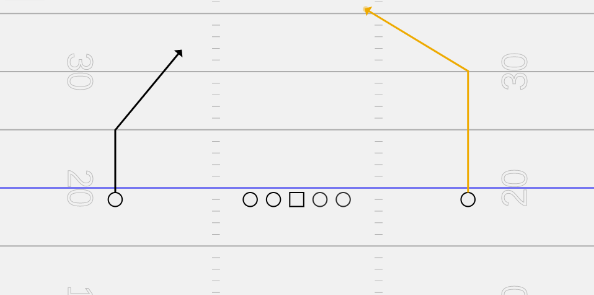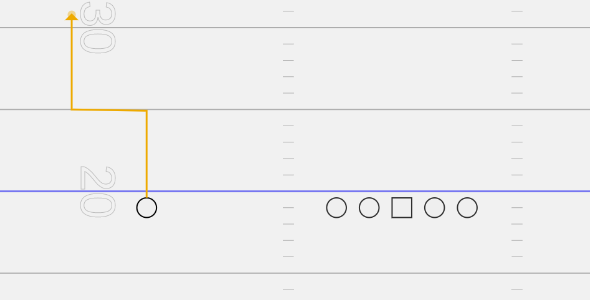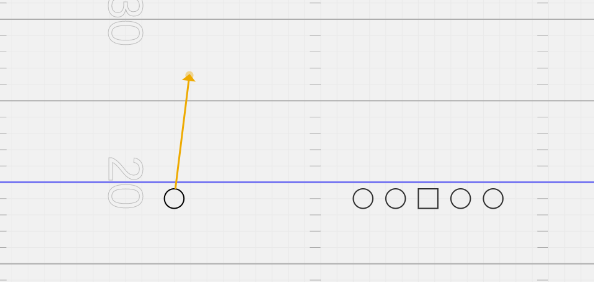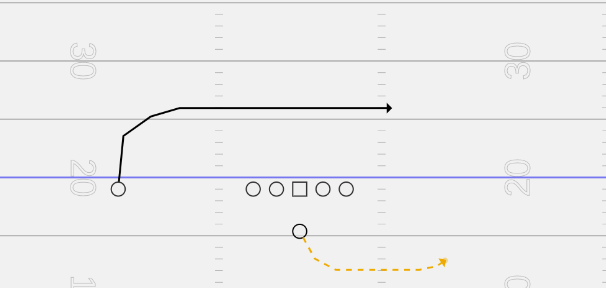One way to move the ball down the field during a football game is through the air. A team’s passing game is predicated on the receivers and quarterback being on the same page.
A receiver needs to run a great route, and the quarterback needs to deliver the ball on time and in a good catchable spot.
This article will talk through some of the most common routes we see in an NFL game. These routes are practiced repeatedly and often start at a young age.
Receivers will begin running routes during flag and youth football games.
A football route tree is designed to let the wide receivers know what route to run and there are normally nine basic routes. The routes normally get longer as the number gets higher. Numbers 1-4 are normally a short route. Number 5-7 are deep middle routes. and 8-0 are deep or a go route.
However, play callers are now starting to use passing concepts instead of a traditional route tree. These concepts are easier to call in the huddle as you can call a route combination with one call sign.
Example – A play caller can use the term “Sky” to tell the wide receivers that they are combining routes. The outside receiver may run a vertical route, and the inside receiver runs a wheel route.
Contents
Most common routes in football for beginners
There are many different football routes, and many of the same routes are called different names by different coaches.
All of the football routes are typically describes as being a part of the “route tree,” and here is an awesome video that breaks down all the route variations:
As a youth football coach and offensive coordinator, I like to give my receivers visual aids before they try to run the routes in practice or games.
Here is a breakdown of my favorite football routes to call on game day:
1. Quick slant
The quick slant route is one of the first routes a kid will learn. It’s a very quick-timing pass where the quarterback has the ability to get the ball out of his hands quickly to hit a receiver going across the middle.
If the quarterback holds the ball too long, he will risk getting sacked and could lead the receiver into a dangerous spot on the field right at the linebackers.
If the Quarterback can get the ball out quickly, it allows the receiver to catch the ball before the linebackers and give them the ability to gain easy yards after the catch.
The slant route can be thrown to either the inside or outside receiver.
If you throw it to the inside receiver he would need to run it a little more skinny to get on top of the linebackers. If throwing to the outside receiver, the slant route should be thrown quick before he reaching the outside linebacker.
One of the best receivers to ever run this route was Jerry Rice! His route-running ability and speed were second to none. Jerry perfected the quick slant, which lead to many of his receiving yards and touchdowns!
2. In-Route
An in-route is usually run at either 5 or 10 yards towards the middle of the field. When you are running an in-route it means you are running toward the ball. Adversely when you run an out route, you will be running away from the ball, the wide receiver should run toward the sideline.
The picture above shows both a 5 and 10-yard route from opposite sides of the football.
This lets the quarterback know that the receiver will run ‘in’ toward the middle of the field. When a receiver is running a 5-yard in, the quarterback will most likely be taking a 5-step drop, but when they are running a 10-yard in, it might require a 5 or 7-step drop to allow the receiver more time to run his route.
3. Out-Route
Like the in-route, the out-route normally runs at 5 or 10 yards. However, in an out route, a wide receiver will be running away from the football or toward the sideline.. For a receiver to have enough space before he hits the sideline, he may need to start more inside to allow space to catch the ball and run upfield.
The out route is extremely difficult to run at younger ages since it creates a long throw for the quarterback to make.
Meaning the longer the ball is in the air, and more opportunity a corner has to make a play on the football.
The out route is a very basic route and is typically run by the slot or tight end. Sometimes the outside receiver won’t have enough space between him and the sideline to complete the pass.
You need to create space from the defender in order to give the quarterback a big enough window to throw the pass accurately one using a few steps in his dropback.
4. Post Route
A post route can also be run at both 5 and 10 yards, as pictured above. A post route in football is an inside route meaning the receiver runs toward the inside, or middle of the field.
The quarterback throws the ball on a line towards the middle of the field between the linebacker and the middle defender.
Its also very similar to a quick slant but is meant to be run deeper and take more time to develop.
The receiver takes about 3-5 steps and should be run deeper and more vertical than a slant route.
An easy way to remember a post route is to think about the receiver breaking towards the goal post.
5. Flag Route
A flag route, or corner route in football is basically the opposite of a post route.
A flag route should be a vertical route ran to toward the sideline at either 5 or 10 yards.
This can also be a very long throw for the quarterback to make. It can be very useful as the receiver is normally running away from the safety who is in the middle of the field, but the long throw means the defender will have more time to react to the play.
A corner route is easy to remember because you are running toward the sideline or corner of the field.
A corner route often times is throwing to the sidelines and out of bounds so only the receiver has the opportunity to catch it.
6. Post-Corner
The post-corner route in football means exactly how it sounds. The receiver is faking as if he’s running a post route and quickly changes position and jets out to the corner toward the sideline.
This can be very effective if ran correctly.
The key for the wide receiver is to make the cornerback’s hips turn toward the middle of the field like you are running a post route.
Once he turns his hips, it can be very difficult for them to recover.
This route can create a ton of separation, however requires a lot of time. Blockers will need to ensure the quarterback has plenty of time for this play to develop.
If they can, then the post corner can but a big play for the offense.
Here is a great video breaking down the post corner:
7. Chair-Route (Out and Up)
This is another move that takes some time to develop. If your lineman cannot create enough time for the quarterback to throw, then this is not a route to run.
However, if you can get some time for your quarterback, this route is one of my favorite football plays to call when we have a mismatch on the outside.
This is called a chair route because when you draw it out, it actually looks like a chair. The receiver will fake a quick 5-yard out, then turn upfield for a go route.
8. Go Route (Fade)
A go route, or fly route in football, is when a receiver runs deep. Usually this route is the number 9 on the route tree.
If you have 1 on 1 coverage on the outside, with no safety over the top, and a fast receiver, a fade route can create some easy points.
When there is deep route called, the coach says, my receiver is faster and better than your cornerback, and we are going deep!
The coach may also call a hail-mary call when every receiver is running a deep route because its the last play of the game and the offense needs a touchdown.
9. Squirrel Route
A squirrel route in football is when a receiver is faking a quick slant and quickly runs an out route. This may look like a long developing route; however, it’s meant to be run quickly and get the ball out fast.
These football routes is also known as a pivot route and usually is not on the normal route tree.
This can be called as a hot route as well if the quarterback sees something on the line of scrimmage that would allow him to change this route with the wide receivers.
The goal here is to get the corner to jump a quick slant and then create a wide-open throw to the outside.
This route is recommended when you have burnt the defense on quick slants over time and can see them cheating on the routes.
10. Seem Route
The seam route may look like a fly route; however, its very different.
A seem route is meant to be thrown quickly up the middle or in the ‘seam’ of the defense. Usually, run between the corner and linebackers, and before the safety.
The pass needs to be thrown very quickly in a tight window, but can be very useful for quick yardage. This can also be an option route that is called at the line of scrimmage.
If the quarterback sees a blitz coming he can quickly call a seam route to the wide receivers and hit them for quick completion.
11. Drag Route
A drag route is typically run to the slot receiver or tight end running across the center of the field. This not a squared-off route, but more of a curve.
It is ran either in front of, or right behind the linebackers. As the receiver flows behind the coverage the quarterback can hit him in stride, and can lead to tons of yards after the catch.
Usually the route is being run when a quarterback is rolling out to the same side.
As seen in the picture above the quarterback and wide receiver runs along the line of scrimmage which helps make it a easier throw for the quarterback to make.
However there are times when a quarterback will hit a drag route with a normal drop back.
12. Curl Route (Hitch Route or Dig Route)
A curl or ‘hitch’ route is also a route normally run at either 5 or 10 yards. In both instances, the receiver will act like he is running a deep go or fade route. This can also be known as a dig route or comeback route. A dig route is a quick pass and requires very few steps from the quarterback.
As soon as the corner opens his hips to run with the go route, the receiver will cut back sharply toward the quarterback.
A dig route or comeback route can be thrown to any receiver and often times is part of combining routes.
A comeback route is a very safe and short route.
If timed right, this can be used for easy yardage. A receiver will also be taught to curl or hitch in the ‘window’ of zone defense, giving the quarterback a clear passing lane to hit him in soft coverage.
The curl route is a great way to pick up quick yardage. These quick routes can be very frustrating to a defense. You can use the curl route kind of like a running play.
If you get a big receiver that can box out a smaller corner, this route can really get quick yardage fast.
Conclusion
These aren’t the only routes we see in a football game. However, for most youth players, these 11 routes are the first 11 they will learn in any football route tree.
When your players line up the line of scrimmage in a game, you don’t want them thinking about what routes they need to run.
So they key here is practice the timing of each route.
To find receivers open, sometimes it takes route schemes and combination routes. You may have to incorporate other routes than the ones above and have specific passing plays ready to win games.
This means having different receivers run routes over the top of each other to confuse the defensive backs. Coaches will use these routes together to confuse a defense and help the quarterback find an open guy. You can create your route tree however you would like.
Remember, simple is better, and less is more. Keep it simple out there and allow your athletes to really grasp these routes and concepts. You don’t want your receivers running straight downfield with no structure or design. Creating a pass play that makes sense is key to beating a defense.

